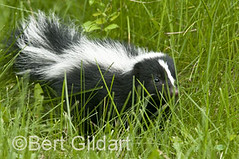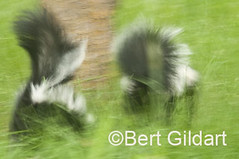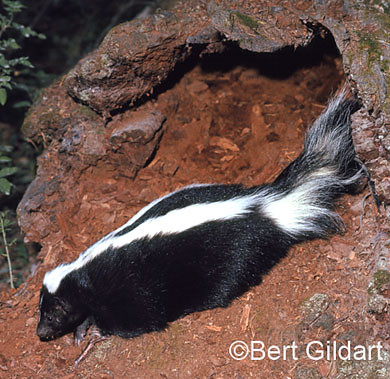Striped Skunks Now Our Neighbors
©Bert Gildart: This past week we’ve been trying to make the acquaintance of a new family that has probably been here for some time, though we’re just now meeting them.
At the moment the family consists of two young and one adult female, and all three are characterized by black bodies punctuated by two broad white stripes running along each side of their bodies. On all the stripes join into a broader white stripe at the back of the neck. The stripe is then interrupted by a small patch of black, but then picks up immediately, running along the center part of each of their foreheads.
Of course, I’m describing what now remains of a family of striped skunks, and because family units are generally larger, I’m assuming one of the Great Horned Owls we frequently hear at night from the huge nearby cottonwood may have taken several. Or maybe it was one of the feral dogs or cats, which we sometimes see and cuss.
Janie saw our skunk family the other night from our kitchen window. They were emerging from beneath a hole along the side of our neighbor’s outbuilding. From the building the two small young made their way to our front door, and for awhile, we could hear the soft movement of their paws in the gravel.
RANGE OF TOLERANCE
Grabbing my camera I had to see what their response would be. Upon opening the door, they turned tail (literally), and then elevated their three bushy tails as though choreographed. I kept my distance, and they kept their spray, only threatening me when I approached too closely. I assumed they must have a range of tolerance, and I certainly intended to keep it.
We live in a farming community and some of our neighbors enjoy them as do we. But not everyone feels the same. In fact, the other night a friend exclaimed :
“We don’t need skunks around here!”
Janie responded saying that skunks may sometimes defend themselves with spray, but when left alone they go about their business in ways that can sometimes be beneficial. Our immediate neighbor, the one whose out building under which they have taken up residence, agrees.
THEIR BIOLOGY
Actually, skunks benefit us all (more from my previous skunk postings). Feeding between dusk and dawn, they search for mice, eggs, carrion, insects, grubs, and berries. At sunrise, they retire to their dens, which may be a hole beneath a building, a rock pile or simply a burrow in the ground. Skunks do not hibernate but instead become semi-active or simply take long naps.
In February or March, mating occurs, and by early May, after a 42- to 63-day gestation period, a litter of about five or six young is born. The young are born blind, but as they mature, follow their mother until late June or early July.
GOOD PETS
I’ve been told that skunks actually make pretty good pets, and in fact, this last image is of a tame skunk. At the time I was working for a newspaper and a young man, who had once been a student of mine, knew I also photographed wildlife, and said we could take his desented skunk into the woods and find a good setting. This old log worked and the two old Metz Strobes provided the proper lighting. I recall that the skunk was affectionate and that it was easy to transport. Later yet, I used the image in a Mammal book which I produced in cooperation with Glacier National Park.
As I say, I’ve had a long association with stripped skunks and see no reason to harm them unless they’re getting into someone’s chicken coop.
——————————————————————————–
THIS TIME THREE YEARS AGO:
ADS FROM GOOGLE AND AMAZON AUGMENT OUR TRAVELS:





June 24th, 2010 at 5:56 pm
Bert, the photo of your new little friends “turning tail” is a little blurry. Not the usual Gildart crisp and sharp technically perfect photo we are all use to seeing from you.
I bet your allergies where bothering you at the moment you squeezed off the picture, right?
Tom
June 28th, 2010 at 10:04 am
Could be — and the fact, I was concerned that they might let loose, which was of greater concern than when we were “shooting” scorpions.